The AMD Radeon RX 5500 XT Review, Feat. Sapphire Pulse: Navi For 1080p
by Ryan Smith on December 12, 2019 9:00 AM ESTPower, Temperature, & Noise
Last, but not least of course, is our look at power, temperatures, and noise levels. While a high performing card is good in its own right, an excellent card can deliver great performance while also keeping power consumption and the resulting noise levels in check.
| Radeon Video Card Voltages | |||||
| 5700 Max | 5500 XT Max | 5700 Idle | 5500 XT Idle | ||
| 1.025v | 1.141v | 0.775v | 0.700v | ||
Back when the RX 5700 series launched, AMD’s voltages surprised me; the RX 5700 XT went as high as 1.2v on TSMC’s 7nm process. For better or worse, it looks like those voltages aren’t a fluke, as we see high voltages with the RX 5500 XT as well. In this case the card tops out at 1.141v, a not insubstantial decrease from the RX 5700 XT, though it’s still relatively high. AMD’s GPUs are still the only high-throughput GPU-like product we’ve seen voltages for on this process, so it’s hard to say whether this is a TSMC thing or an AMD thing. But either way, as AMD’s own voltage/frequency curve helpfully illustrates, the last couple of hundred MHz on the RX 5500 XT gets to be quite expensive in terms of power.
| Radeon Video Card Average Clockspeeds (Rounded to the Nearest 10MHz) |
|||
| Game | 5500 XT | 5700 | |
| Max Boost Clock | 1860MHz | 1750MHz | |
| Official Game Clock | 1717MHz | 1625MHz | |
| Tomb Raider | 1810MHz | 1680MHz | |
| F1 2019 | 1810MHz | 1650MHz | |
| Assassin's Creed | 1750MHz | 1700MHz | |
| Metro Exodus | 1800MHz | 1640MHz | |
| Strange Brigade | 1840MHz | 1660MHz | |
| Total War: TK | 1840MHz | 1690MHz | |
| The Division 2 | 1800MHz | 1630MHz | |
| Grand Theft Auto V | 1830MHz | 1690MHz | |
| Forza Horizon 4 | 1830MHz | 1700MHz | |
Despite that power cost, however, the RX 5500 XT manages to keep its clockspeeds rather high. Even without Sapphire’s higher power cap performance BIOS, their 8GB card is frequently at 1800MHz or better, putting it well ahead of AMD’s official game clock of 1717MHz. This means the card is running fairly close to its clockspeed limit – so Sapphire’s extra power doesn’t do a whole lot – but it also means the card is doing all of this on 130W (or less) of power.
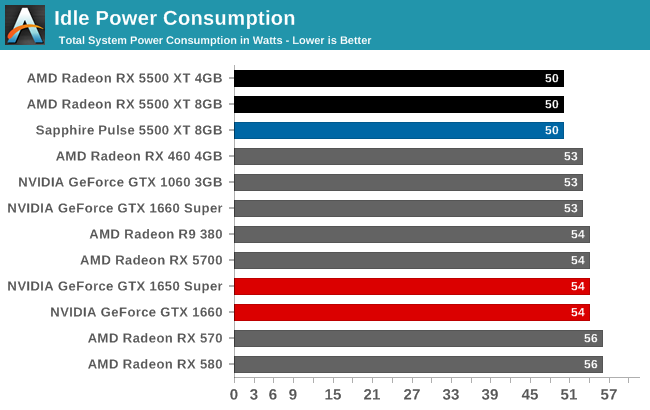
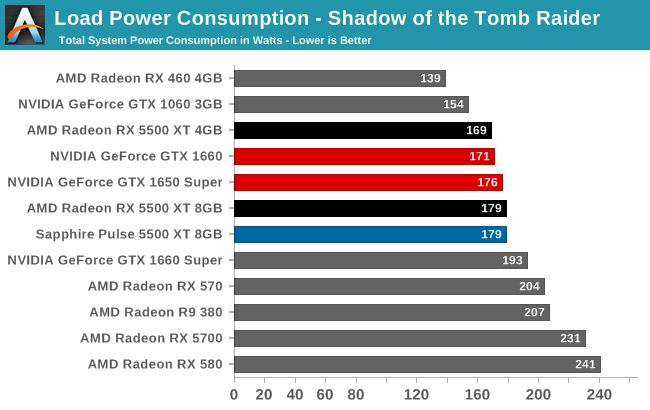
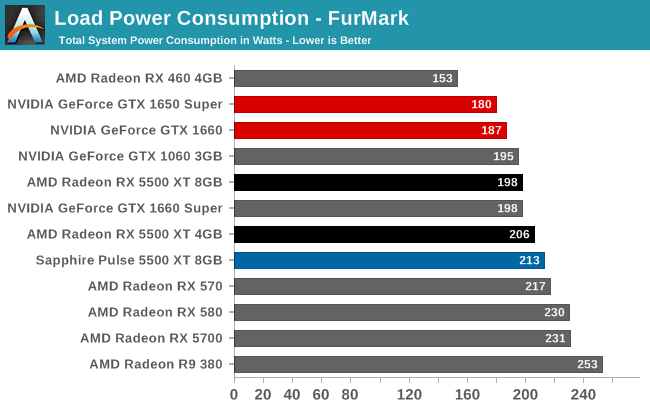
With the combination of TSMC’s 7nm process, AMD’s firmware optimizations, and I suspect the use of just 8 PCIe lanes, the RX 5500 XT fares very well when it comes to idle power. At 50W for the entire system, this is lower than any other configuration by a few watts. Which for idling, where power consumption is already low, is huge. No wonder Sapphire is able to offer zero fan speed idle here; the card is burning very little power at idle.
Similarly, load power is looking fairly good as well. Under Tomb Raider, the total system power consumption with the AMD cards is highly competitive with the NVIDIA competition (though as we’ve seen, actual game framerates trail a bit). Though AMD does fall behind under FurMark, as the 130W+ RX 5500 XT cards all have higher TDPs than NVIDIA’s 120W/125W equivalents, and FurMark will drive all of these cards to their power limits.
In practice, all of this generally reflects the cards’ relative specifications. The RX 5500 XT is able to hang with the somewhat inefficient GTX 1650 Super, however once we get to the more efficient GTX 1660, NVIDIA is consuming less power while delivering better performance.
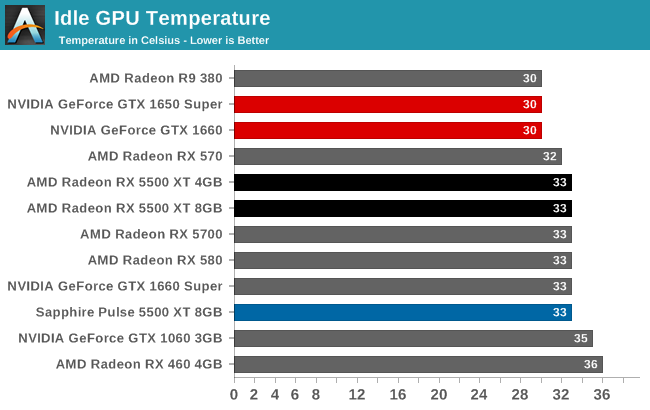


Early on I mentioned that Sapphire’s Pulse cards might be a bit overbuilt, and now that we’re getting into temperature and noise measurements, we get to see why. The idle GPU temperatures are what we’d expect for a zero fan speed idle card; meanwhile the load temperatures don’t crack 70C under Tomb Raider, and even FurMark only pushes the worst card to a well within tolerances 76C.
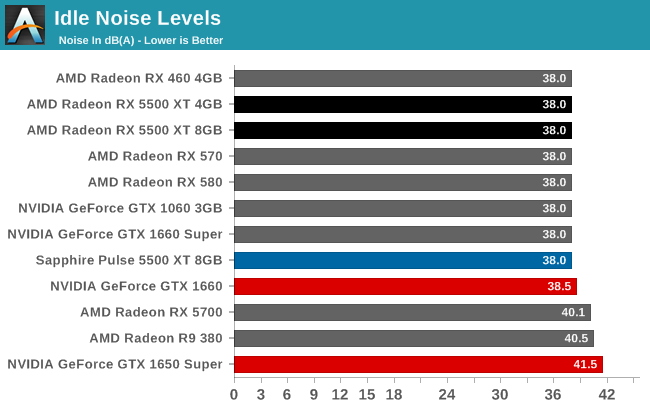
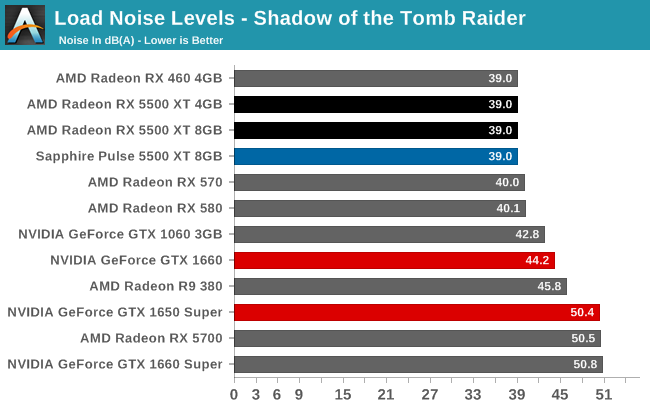
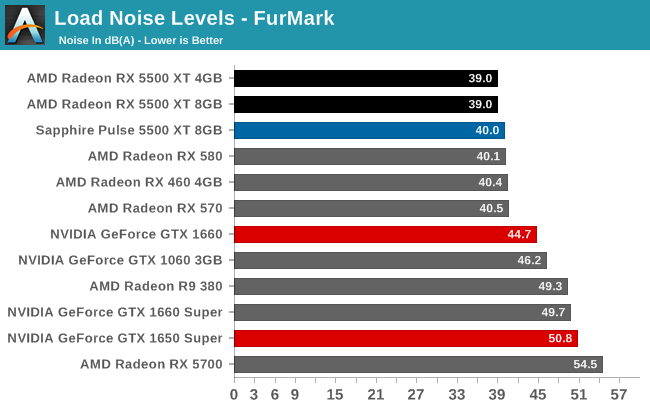
But when we get to noise, this is where Sapphire blows our socks off. Or rather, doesn’t blow our socks off?
The load noise levels I measured here were so low that it required extra effort to properly duplicate the results and isolate noise sources. With a card TDP of 130W, those big 95mm fans end up doing very little work. The PWM and monitoring-enabled fans run at under 800 RPM on gaming workloads, and it’s only when we’re using Sapphire’s higher TDP performance BIOS that the fans crack 1000 RPM.
Sapphire could probably cool a 200W card with this cooler, and I wouldn’t be too surprised to learn that it’s exactly such a card they took it from. But the net result is that while the card is a space hog, it’s a silent space hog. With load noise levels below 40 dB(A) for everything except FurMark, the card is barely louder than the rest of the system. Compared to our GeForce cards, all of which are smaller cards with equally small fans, the difference is extensive. Sapphire may have overbuilt their card, but as a result they’ve struck a great balance between temperatures and cooling performance, and delivering great acoustics in the process.


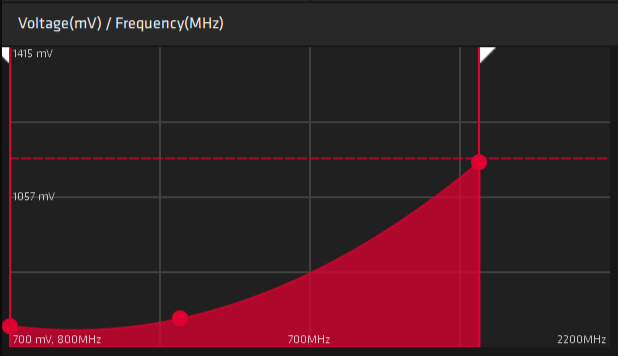








97 Comments
View All Comments
Freeb!rd - Friday, December 13, 2019 - link
For those of us with older cards, I would've appreciated the GTX 1060 6GB & GTX 1070 included in the performance graphs.Freeb!rd - Friday, December 13, 2019 - link
Especially since I have both those and some 580s lying around.sheh - Friday, December 13, 2019 - link
https://www.anandtech.com/bench/product/2577?vs=25...alfatekpt - Friday, December 13, 2019 - link
Depending on price it seems it can actually fight with 1660 Super because the differences are a few FPS with a lower noise/power consumption.ballsystemlord - Saturday, December 14, 2019 - link
@ryan If you can't run opencl on windows why not run your tests on Linux? I'd imagine that some of the programs have a version that runs on Linux.isthisavailable - Saturday, December 14, 2019 - link
The 8 gb version should not exist and the 4gb version should be $10 lower to match 1650super in price while beating it in perf. Why would you buy 8gb version when NVIDIA has 1660 for $10 more.Also, rx5500 gaming laptops when?
Maxxie - Saturday, December 14, 2019 - link
This looks like a gaming card, again. For the professional segment, AMD needs to focus more on compute and reducing operating power/temperature. I was forced to upgrade a working AMD RX 580 4gb to Nvidia's RTX 2060 Super 8gb to get GPU acceleration working in MATLAB. Major benefit the doubled graphics memory, and the new card runs noticeable cooler. Still, I spent $300 on the RX 580 earlier this year wasting a bit of budget. That's going to keep me from trying any AMD cards until they give focus to more than the entertainment segment.dr.denton - Sunday, December 15, 2019 - link
I really don't know much about professional use, but has this not been AMD's biggest problem in the past years? Having GPUs with great compute abilities, but somewhat lacking for gaming?Personally, I'm glad they finally have the ressources to develop two lines of architectures, one focussed on gaming and one for professional use.
ballsystemlord - Saturday, December 14, 2019 - link
One grammar mistake:"...one that TSMC's customers are jockeying to secure wafer starts due to very high demand."
Missing "for":
"...one that TSMC's customers are jockeying to secure wafer starts for due to very high demand."
Father Time - Saturday, December 14, 2019 - link
Closing Thoughts -> 4th last paragraph:"6% more perforamnce".
Great article though.
Does AMD still suffer from Day 1 performance not reflecting the huge gains they get over NVidia as drivers mature? It was a large issue in generations passed (ever since the 2900XT), and considering how close this card is to the NV equivalents, do we expect it to win out over time, or is that a thing of the past now that architecture has changed significantly, along with the technology and the people involved?